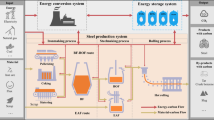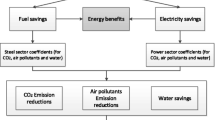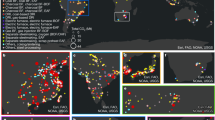Abstract
Identifying the key factors influencing energy consumption and CO2 emissions is necessary for developing effective energy conservation and emission mitigation policies. Previous studies have focused mainly on decomposing changes in energy consumption and CO2 emissions at the national, regional, or sectoral levels, while the perspective of site-level decomposition has been neglected. To narrow this gap in research, a site-level decomposition of energy- and carbon-intensive iron and steel sites is discussed. In this work, the logarithmic mean Divisia index (LMDI) method is used to decompose the changes in the energy consumption and CO2 emissions of iron and steel sites. The results show that the production scale significantly contributes to the increase in both energy consumption and CO2 emissions, with cumulative contributions of 229.63 and 255.36%, respectively. Energy recovery and credit emissions are two key factors decreasing site-level energy consumption and CO2 emissions, with cumulative contributions to the changes in energy consumption and CO2 emissions of −158.30 and −160.45%, respectively. A decrease in energy, flux, and carbon-containing material consumption per ton of steel promotes direct emission reduction, and purchased electricity savings greatly contribute to indirect emission reduction. In addition, site products and byproducts promote an increase in credit emissions and ultimately inhibit an increase in the total CO2 emissions of iron and steel sites.















Similar content being viewed by others
References
Ang B, Zhang F (2000) A survey of index decomposition analysis in energy and environmental studies. Energy 25(12):1149–1176
Ang B, Zhang F, Choi K (1998) Factorizing changes in energy and environmental indicators through decomposition. Energy 23(6):489–495
Akbostancı E, Tunç G, Türüt-Aşık S (2011) CO2 emissions of Turkish manufacturing industry: a decomposition analysis. Appl Energy 88(6):2273–2278
Chen J, Xing Y, Wang Y, Zhang W, Guo Z, Su W (2022) Application of iron and steel slags in mitigating greenhouse gas emissions: a review. Sci Total Environ 844:157041
Chong C, Liu P, Ma L, Li Z, Ni W, Li X, Song S (2017) LMDI decomposition of energy consumption in Guangdong province, China, based on an energy allocation diagram. Energy 133:525–544
Ding K, Li A, Lv J, Gu F (2023) Decarbonizing ceramic industry: technological routes and cost assessment. J Clean Prod 419:138278
Du G, Sun C, Ouyang X, Zhang C (2018) A decomposition analysis of energy-related CO2 emissions in Chinese six high-energy intensive industries. J Clean Prod 184:1102–1112
Du T, Shi T, Liu Y, Ye JB (2013) Energy consumption and its influencing factors of iron and steel enterprise. J Iron Steel Res Int 20(8):8–13
Fu W, Sun W, Huo X (2013) Design and thermodynamic investigation of a waste heat-assisted compressed air energy storage system integrating thermal energy storage and organic Rankine cycle. Energy Technol 12:202300838
González PF, Presno MJ, Landajo M (2024) Tracking the change in Spanish greenhouse gas emissions through an LMDI decomposition model: a global and sectoral approach. J Environ Sci 139:114–122
Guo J, Gu F, Liu Y, Liang X, Mo J, Fan Y (2020) Assessing the impact of ETS trading profit on emission abatements based on firm-level transactions. Nat Commun 11:2078
Hasan M, Liu K (2022) Decomposition analysis of natural gas consumption in Bangladesh using an LMDI approach. Energy Stra Rev 40:100724
Inayat A (2023) Current progress of process integration for waste heat recovery in steel and iron industries. Fuel 338:127237
International Energy Agency (2020) Iron and steel technology roadmap: towards more sustainable steelmaking.
Jain S, Rankavat S (2023) Analysing driving factors of India’s transportation sector CO2 emissions: based on LMDI decomposition method. Heliyon 9(9):e19871
Jiborn M, Kander A, Kulionis V, Nielsen H, Moran D (2018) Decoupling or delusion? Measuring emissions displacement in foreign trade. Global Environ Change 49:27–34
Li Y, Wang S, Chen B (2019) Driving force analysis of the consumption of water and energy in China based on LMDI method. Energy Procedia 158:4318–4322
Liu S, Sun W (2023) Attention mechanism-aided data- and knowledge-driven soft sensors for predicting blast furnace gas generation. Energy 262:125498
Liu SH, Sun WQ, Li WD, Jin BZ (2023) Prediction of blast furnace gas generation based on data quality improvement strategy. J Iron Steel Res Int 30(5):864–874
Ma S, Ding W, Liu Y, Ren S, Yang H (2022) Digital twin and big data-driven sustainable smart manufacturing based on information management systems for energy-intensive industries. Appl Energy 326:119986
Ma S, Huang Y, Liu Y, Kong X, Yin L, Chen G (2023a) Edge-cloud cooperation-driven smart and sustainable production for energy-intensive manufacturing industries. Appl Energy 336:120843
Ma S, Huang Y, Liu Y, Liu H, Chen Y, Wang J, Xu J (2023b) Big data-driven correlation analysis based on clustering for energy-intensive manufacturing industries. Appl Energy 349:121608
Ma S, Sun W (2023) Design and experimental investigation of a natural gas burner for pellet rotary kilns. Int J of Oil Gas Coal Technol 34(2):173–186
Na H, Sun J, Qiu J, Yuan Y, Du T (2022) Optimization of energy efficiency, energy consumption and CO2 emission in typical iron and steel manufacturing process. Energy 257:124822
Qing G, Luo Y, Huang W, Wang W, Yue Z, Wang J, Li Q, Jia S, Sun S (2021) Driving factors of energy consumption in the developed regions of developing countries: a case of Zhejiang province, China. Atmosphere 12(9):1196
Sun W, Wang Q, Zheng Z, Cai J (2020a) Material-energy-emission nexus in the integrated iron and steel industry. Energy Convers Manag 213:112828
Sun W, Wang Q, Zhou Y, Wu J (2020b) Material and energy flows of the iron and steel industry: status quo, challenges and perspectives. Appl Energy 268:114946
Sun W, Shao Y, Zhao L, Wang Q (2020c) Co-removal of CO2 and particulate matter from industrial flue gas by connecting an ammonia scrubber and a granular bed filter. J Clean Prod 257:120511
Tang D, Ma T, Li Z, Tang J, Bethel B (2016) Trend prediction and decomposed driving factors of carbon emissions in Jiangsu province during 2015–2020. Sustainability 8(10):1018–1018
Wang H, Zhou P (2018) Multi-country comparisons of CO2 emission intensity: the production-theoretical decomposition analysis approach. Energy Econ 74:310–320
Wang J, Wang Q, Sun W (2023a) Optimal power system flexibility-based scheduling in iron and steel production: a case of steelmaking–refining–continuous casting process. J Clean Prod 414:137619
Wang J, Wang Q, Sun W (2023b) Quantifying flexibility provisions of the ladle furnace refining process as cuttable loads in the iron and steel industry. Appl Energy 342:121178
Wang M, Feng C (2018) Decomposing the change in energy consumption in China’s nonferrous metal industry: an empirical analysis based on the LMDI method. Renew Sustain Energy Rev 82:2652–2663
Wang X, Yan L (2022) Driving factors and decoupling analysis of fossil fuel related-carbon dioxide emissions in China. Fuel 314:122869
Wei N, Liu S, Jiao Z, Li X (2022) A possible contribution of carbon capture, geological utilization, and storage in the Chinese crude steel industry for carbon neutrality. J Clean Prod 374:133793
Xi H, Wu X, Chen X, Sha P (2021) Artificial intelligent based energy scheduling of steel mill gas utilization system towards carbon neutrality. Appl Energy 295:117069
Xiao Y, Ma D, Zhang F, Zhao M, Wang L, Guo Z, Zhang J, An B, Xiao Y (2023) Spatiotemporal differentiation of carbon emission efficiency and influencing factors: from the perspective of 136 countries. Sci Total Environ 879:163032
Xin H, Wang S, Chun T, Xue X, Long W, Xue R, Zhang R (2023) Effective pathways for energy conservation and emission reduction in iron and steel industry towards peaking carbon emissions in China: case study of Henan. J Clean Prod 399:136637
Yasmeen H, Wang Y, Zameer H, Solangi YA (2020) Decomposing factors affecting CO2 emissions in Pakistan: insights from LMDI decomposition approach. Environ Sci Pollut Res Int 27(3):3113–3123
Yang F, Yang X, Tian X, Wang X, Xu T (2023) Decomposition analysis of CO2 emissions of electricity and carbon-reduction policy implication: a study of a province in China based on the logarithmic mean Divisia index method. Clean Energy 7(2):340–349
Yang J, Cai W, Ma M, Li L, Liu C, Ma X, Li L, Chen X (2020) Driving forces of China’s CO2 emissions from energy consumption based on Kaya-LMDI methods. Sci Total Environ 711:134569
Yao X, Shah W, Yasmeen R, Zhang Y, Kamal M, Khan A (2021) The impact of trade on energy efficiency in the global value chain: a simultaneous equation approach. Sci Total Environ 765:142759
Yu X, Zhang M (2014) Decomposition of factors influencing carbon emissions in the region of Beijing–Tianjin–Hebei, based on the perspective of terminal energy consumption. Chin J Popul Resour Environ 12(4):338–344
Zhang H, Sun W, Li W, Ma G (2022) A carbon flow tracing and carbon accounting method for exploring CO2 emissions of the iron and steel industry: an integrated material–energy–carbon hub. Appl Energy 309:118485
Zhu X, Zou J, Feng C (2017) Analysis of industrial energy-related CO2 emissions and the reduction potential of cities in the Yangtze River Delta region. J Clean Prod 168:791–802
Funding
This work was supported by the National Natural Science Foundation of China (52334008).
Author information
Authors and Affiliations
Contributions
Both authors contributed to the study’s conception and design. Data collection, visualization, and analysis were performed by J Wang and W Sun. The first draft of the manuscript was written by J Wang, and both authors commented on previous versions of the manuscript. Both authors read and approved the final manuscript.
Corresponding author
Ethics declarations
Ethical approval
Not applicable.
Consent to participate
Not applicable.
Consent to publish
Not applicable.
Competing interests
The authors declare no competing interests.
Additional information
Responsible Editor: V.V.S.S. Sarma
Publisher’s Note
Springer Nature remains neutral with regard to jurisdictional claims in published maps and institutional affiliations.
Rights and permissions
Springer Nature or its licensor (e.g. a society or other partner) holds exclusive rights to this article under a publishing agreement with the author(s) or other rightsholder(s); author self-archiving of the accepted manuscript version of this article is solely governed by the terms of such publishing agreement and applicable law.
About this article
Cite this article
Wang, J., Sun, W. Decomposition of the site-level energy consumption and carbon dioxide emissions of the iron and steel industry. Environ Sci Pollut Res 31, 16511–16529 (2024). https://doi.org/10.1007/s11356-024-32162-y
Received:
Accepted:
Published:
Issue Date:
DOI: https://doi.org/10.1007/s11356-024-32162-y




